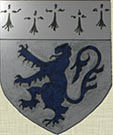 |
SKELTON - IN - CLEVELAND
IN HISTORY
|

|
"WE WILL REMEMBER THEM"
63073 Driver JOHN LANGSTAFF.
"C" Battery, 77th Howitzer Brigade, Royal Field Artillery.
Died, aged about 30, on the 19th June 1917.
Born at Moorsholm, N Yorks. Enlisted at Morton-on-Swale, nr Northallerton, N Yorks.
Husband of Mrs Mary Ellen Holt, 75 Tumblinghill St, Bradford, Yorks.
|

Poperinghe New Military Cemetery.
|
FAMILY
Of the 100 men on the Skelton Memorials this one has proved the hardest to trace.
The Skelton War Memorial records just J LONGSTAFF.
The plaque in Skelton Church gives the same name and places him in the Royal Field Artillery as a Bombardier.
Only two people with this name could be found in the Skelton area in the pre-War period and neither fitted the details of men who died in the First War.
By chance the following entry in the Skelton Parish Magazine for 1910 was found:-

Thanks to research kindly contributed by Dorothy Harris of Saltburn and Owen Rooks, native Skeltoner and now of Sunderland, this John Longstaff has been identified as John Langstaff.
Dot Harris some years ago contributed a photograph and family details of her Great Uncle, Richard Matthew Thorpe, who died as a Prisoner of War on the 8th June 1918 and is commemorated on the North Skelton Memorial.
It turns out that Richard was the brother of Mary Ellen Thorpe, who married John LANGSTAFF [not Longstaff].
John was born in Moorsholm, N Yorks, about 3 miles from Skelton, in 1886. On the 1891 census he was living there, with his father, also John, an Ironstone Miner and native of Durham, mother Elizabeth of Moorsholm and
3 younger siblings.
In 1901, the family had moved to Stanghow, but John, aged 15, was working as a Farm Labourer on William Bonas's farm at Botton, near Danby, N Yorks.
Mary Ellen Thorpe was aged 12 and living at 4 Steavenson St, Kilton, N Yorks.
As the Parish Magazine cutting shows they married on the 16th July 1910 and in 1911 were living at Home Farm Cottages, Grinkle, near Loftus, N Yorks, where John worked as a Horseman.
Their first child Irene had been born that year. In the Quarter ending September 1912 a second child, Laura, was registered at Whitby, N Yorks.
On the 23rd March 1919 Mary Ellen Langstaff [widow] married Herbert Holt at Bradford, St John, Yorkshire.

This last fact was the best evidence yet found that John Langstaff had died in his late 20s and is the man named on the Skelton Memorial.
Owen Rooks then did further digging in the records and found that the young family moved around a lot, presumably looking for farm work, and the two daughters sadly died young.
Irene, aged 3, in December 1914, at Easingwold, near York.
Laura, aged 4, at Pontefract, in September 1916, by which time John was in France.
Then John's Commonwealth War Graves certificate provided conclusive proof that this is the man on the Skelton Memorial, showing that his next of kin when the cemeteries were made after the War was a Mrs Holt of Bradford.
The search also revealed that John's younger brother Thomas J Langstaff was wounded in the War and received a War pension.
WAR SITUATION.
John Langstaff was a horse Driver in the Royal Field Artillery, which confirms that the Church Plaque was nearly correct and ties in with him being a horseman on local farms.
His Medal Card shows that he was a Volunteer and first went to France on the 28th September 1915.

The 77th Brigade of the RFA used Howitzers, artillery weapons that fired shells in a looping trajectory and John was no doubt employed hauling the constant supply of ammunition.
The 77th Bde was part of the 16th Division, which during 1916 had taken part in the Battles of Guillemont and Grinchy, phases in the Battle of the Somme.
On the 19th June 1917, when John Langstaff died, it had just been engaged in the Battle of Messines, just South of Ypres, a prelude to the Third Battle of Ypres or Passchendaele.
Messines was a successful British offensive in which countless Germans were killed by the explosion of a massive mine.
The circumstances of his death are not known. Commonwealth War Graves gives Died rather than Killed in Action or Died of Wounds.
MEMORIAL.
He is buried at Poperinghe, a Belgian village about 10 kilometres to the West of Ypres. For most of the War this was out of range of German artillery and was used for Casualty Clearing stations.
The cemetery contains 677 Commonwealth burials and 271 French.
|
|